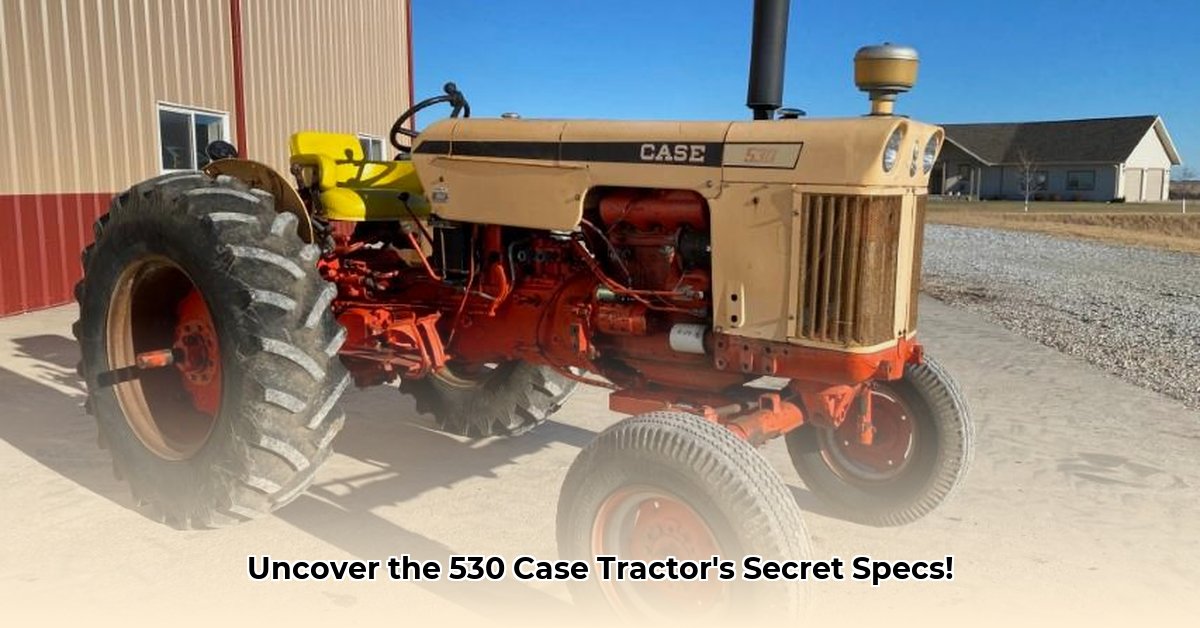
530 Case Tractor Specs: A Deep Dive into a Farming Icon
The J.I. Case 530 tractor, a workhorse of the 1960s, holds a special place in agricultural history. This comprehensive guide explores its specifications, operational nuances, maintenance, and restoration, appealing to both seasoned mechanics and history enthusiasts. We'll examine the variations within the model line (530, 531, 540, 541, and the robust 530CK) and provide practical advice for keeping this classic machine running smoothly. Isn't understanding the intricacies of this iconic tractor a rewarding endeavor? For more on Case 730 tractors, see this helpful resource: 730 Case Specs.
The Heart of the Matter: Engine and Transmission
The Case 530’s power stemmed from a reliable 3.1-liter engine, available in gasoline and diesel variants. This variation led to the creation of several models, each with subtle differences. While boasting approximately 40 belt horsepower, the actual drawbar (power to the wheels) and PTO (power take-off) horsepower were somewhat lower, reflecting typical power delivery characteristics of that era. Transmission options ranged from basic 4-speed gearboxes to more advanced 12-speed units and even 8-speed torque converters, catering to diverse farming needs and budgets. Did the choice of transmission significantly impact a farmer's daily operations?
Sizing Up the 530: Dimensions and Key Capacities
Understanding the 530's dimensions is crucial, whether for restoration or storage. Note that these are approximate, and variations exist across models:
| Specification | Measurement (Approximate) | Units | Notes |
|---|---|---|---|
| Length | 11 feet | Feet | May vary slightly depending on configuration |
| Width | 6 feet | Feet | Influenced by wheel and tire selection |
| Height | 7 feet | Feet | Can be higher with attached implements |
| Wheelbase | Varies by Model | Feet | Consult your specific model's manual |
| Fuel Tank Capacity | 83.3 liters | Liters | Impressive fuel capacity for its time |
| Ground Clearance | Varies by Model | Inches | Essential for navigating uneven terrain |
A Blast from the Past: Historical Context
Produced between 1960 and 1969 in Racine, Wisconsin, and Rock Island, Illinois, the Case 530 reflects the technological advancements of the post-war era. It wasn't merely a tractor; it symbolized progress and efficiency for farmers. Its versatility extended beyond agriculture, with the 530CK (“Construction King”) proving its mettle in various construction projects. How did the 530’s robust design influence its widespread adoption?
Getting Behind the Wheel: Operational Overview
Starting a Case 530 was a ritual: engaging the clutch, turning the ignition, and adjusting the throttle. Driving demanded familiarity with the mechanics. Attaching implements was more hands-on than modern systems, but the three-point hitch system offered efficiency for its time. What unique challenges did operating a 530 present compared to modern tractors?
Keeping it Running: Maintenance and Repair
Regular maintenance is paramount. This includes checking fluids (engine oil, transmission fluid, coolant), lubricating moving parts, and promptly addressing any issues. Finding replacement parts may require more effort than for newer equipment; however, many vintage tractor suppliers specialize in parts for classic models like the 530. How frequently should vital fluids be inspected to ensure optimal performance?
Restoring a Piece of History: Restoration Guidance
Restoring a Case 530 is a rewarding but demanding undertaking. It requires patience, mechanical aptitude, and access to resources. Online forums dedicated to vintage Case tractors are invaluable resources, offering advice, parts leads, and connections with other enthusiasts. Original manuals, if available, provide essential instructions. What unique challenges do restorers face when sourcing parts for a Case 530?
Where to Find More Information: Resources and Further Exploration
The vintage Case tractor community is active and supportive. Online forums, specialty parts suppliers, and agricultural museums offer valuable resources. Your journey into the world of the Case 530 is just beginning – explore and discover!
How to Find Replacement Parts for a J.I. Case 530 Tractor
Securing parts for a vintage Case 530 requires a multi-pronged approach.
Understanding Your Case 530: Models and Variations
Identifying your specific model (530, 530CK, 531, 540, 541) is crucial for accurate part sourcing. These models share some components but have key differences in engines, transmissions, and braking systems. Refer to your tractor’s serial number for precise identification. Why is accurate model identification so critical when searching for replacement parts?
Locating Those Elusive Parts: A Step-by-Step Guide
- Online Retailers: Start with online retailers specializing in vintage tractor parts (e.g., TractorPartsAsap). Verify compatibility before purchasing.
- Case IH Dealers: Some dealers may still stock parts for older models.
- Online Forums and Communities: Engage with online communities for advice and part leads.
- Used Parts Dealers and Salvage Yards: A cost-effective option requiring careful part inspection.
530 Case Tractor Maintenance and Repair Tips
- Fluid Inspections: Regularly check all fluids.
- Cleaning: Regular cleaning aids in early problem detection.
- Lubrication: Prevent wear and tear by lubricating moving parts.
- Prompt Issue Resolution: Address minor problems promptly to avoid major repairs.
Restoring Your Case 530: A Labor of Love
Restoring involves detailed inspection, diligent part sourcing, and potentially engaging specialized shops. Original service manuals are invaluable. What is the single most important resource for a successful Case 530 restoration project?